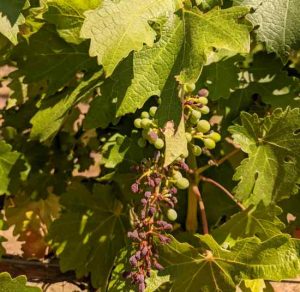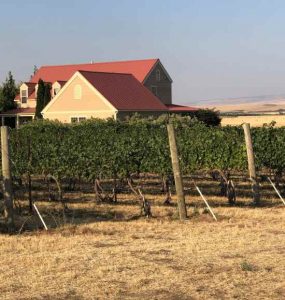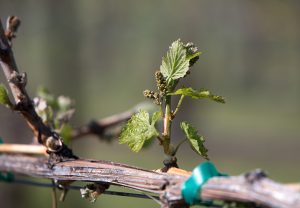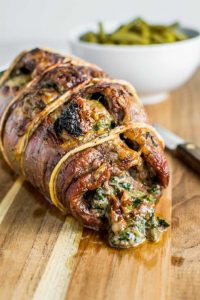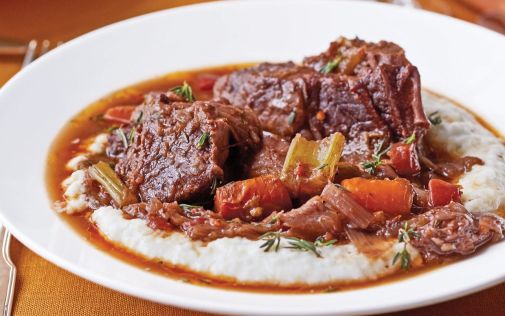Authored by: Neil Johnston, Dumas Station Food & Wine Pairing Expert
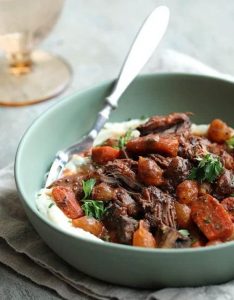
Slow Cooker Boneless Beef Short Ribs
We are visiting beef again this month, but with a twist. This is a boneless beef short ribs recipe that practically cooks itself, and makes its own luscious rich red-wine sauce – no sauce-making skills required, and no de-fatting of the sauce! And it pairs perfectly with Cabernet Franc. This is classic comfort food, and it is healthy too!
Serve this with (or on top of) your favorite healthy carb: polenta, rice, or noodles.
Cook: 2-1/2 to 3-1/2 hours, unattended in the oven
Total Time: 4 hours
Yields: 4 servings
Recommended Wine Pairing: 2017 Cabernet Franc
You will need a dutch oven, a flat-edged wooden pot scraper or a large wooden spoon, and a large sieve for this dish.
Ingredients:
- 2 lbs. boneless beef short ribs
- 2 tbsp vegetable oil for searing, more as needed
- Kosher salt and freshly ground pepper
- 1 medium onion, chopped
- 2 ribs celery, chopped
- 2 medium carrots, chopped
- 4 garlic cloves, chopped
- 3 tbs tomato paste
- 2 tbs flour
- 2 cups red wine
- 2 cups beef stock (ok to use bouillon cube or jarred stock concentrate with water added) – NOTE – if you like sauce, you can increase the amount of red wine and beef stock by an additional 2 cups, keeping the 50:50 ratio, as long as your Dutch oven is large enough. The sauce freezes well and is delicious.
- 4 sprigs thyme
- 1 sprig rosemary
- 1 large bay leaf
AFTER TWO HOURS IN THE OVEN
- 2 medium carrots, peeled, halved and sliced 1/3” thick
- 2 ribs celery, peeled, and sliced
- 1-2 cups (or amount of your preference for four people) baby potatoes, unpeeled
- 1 cup (or to your preference) frozen pearl onions
- 1 cup (or to your preference) whole button mushrooms, quartered
- 1 cup Italian parsley, chopped
- ½ cup finely chopped chives
- grated zest from 1 small lemon
Directions:
- Preheat oven to 275 F.
- Heat oil in a large Dutch oven over medium-high heat. Season short ribs generously on all sides with salt and pepper. Working in batches, sear short ribs on all sides until deeply and evenly browned, 6 to 8 minutes per batch. Look to build up a medium-dark-brown layer on the bottom of the pan; if it is getting too dark or the oil is disappearing, add more oil as needed to continue the searing process, and lower the heat slightly. Remove the seared ribs to a temporary plate.
- Add the first batch of onion, celery, and carrots and season with salt and pepper. Toss to coat and cook until softened but not yet browned, 5 to 10 minutes.
- Make a bare spot in the center of the pan. Add tomato paste and cook until the color darkens, 2-3 minutes. Toss flour onto the vegetables, and stir the tomato paste, flour, and vegetables together, stirring and cooking about 2 minutes. Add the garlic and stir for 1 more minute.
- Reduce the heat to medium. Pour about ½ cup of red wine into the pan (it should sizzle) and use the flat-edged or large wooden spoon to scrape up and dissolve all of the caramelized bits on the bottom of the pan. Continue adding red wine in batches and stir and scrape until the bottom of the pan is clean. Let the wine simmer, in total, about 2 to 3 minutes to burn off some of the alcohol.
- Stir in the beef stock and the thyme, rosemary, and bay leaf.
- Using tongs, return the short ribs to the pot along with any juices that they wept, nestling them into the pot so they are just barely covered. Add more beef stock, or water, if needed to get them barely covered. Reserve the tongs and plate for step 10 below.
- Place the lid on the dutch oven and cook, undisturbed, for 3 hours.
- Meanwhile, if you haven’t already, prepare the second batch of carrots, celery, baby potatoes, onions, and mushrooms.
- After 3 hours, carefully remove the short ribs (they may be tender enough already to fall apart, try not to let them do so) and put them on the plate.
- Place the sieve over a bowl large enough to hold 4 cups of liquid. Use a ladle or large spoon to remove all of the carrots, celery, onions, and herbs from the sauce, and place them into the sieve. When the dutch oven is empty, press down on the sieve to extract as much liquid as possible from the veggies. Discard the sieved veggies. (The beauty of this sauce is that short ribs do not contain a great deal of fat; there is no need to de-fat the resulting sauce. Even if, at this point, you were to refrigerate the sauce overnight, you will find no fat congealed on top the next day.)
- Return all of the now-smooth sauce to the dutch oven, taste it and adjust the salt and pepper if needed. Add the second batch of carrots, celery, potatoes, onions, and mushrooms to the sauce.
- Slice the ribs into 1” to 2” (bite-sized) chunks and add them back to the dutch oven. Gently stir everything together and place the lid back on, and return the dutch oven to your oven.
- Continue to cook for 30 minutes (up to an additional 1 hour won’t hurt if you need the time) – at least until the potatoes and carrots are tender when pierced with the tip of a sharp knife.
- Before serving, give the sauce one more taste, and adjust the salt and pepper if needed. Then, mix together parsley, chives, and lemon zest and scatter over the top. Ladle into large bowls on top of your favorite comfort carb and enjoy.
BONUS DESSERT RECIPE
Chocolate Ganache Éclair Cake (best made the night before)
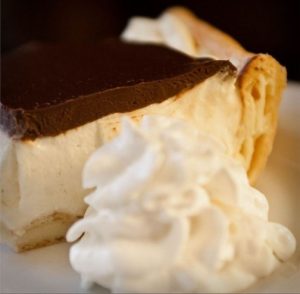
Eclair Cake with Chocolate Ganache and whipped cream
I’ve made this before multiple times, but as individual “profiteroles” which require baking the puff pastry in separate individual “puffs”, piercing and drying them, and cutting them in half for assembly. This recipe is much easier.
(If you want to go old school, and have made pâte à choux before, feel free to make individual puffs. I typically cut them in half and fill them with a small scoop of my favorite ice cream instead of the cream filling below, before putting the top piece on and pouring over the ganache.)
TIP: if you like a softer, shinier ganache, add 2 TBSP corn syrup to it while making. If you have a double oven, you can make this recipe as the short ribs are braising.
Prep: 30 mins
Cook: 25 mins
Additional: 1 hr 45 mins
Total: 2 hrs 40 mins
Servings: 12
Yield: one 9 x 13-inch dish
Ingredients
Pastry Shell:
- 1 cup water
- 1⁄2 cup butter
- 1⁄4 teaspoon salt
- 1 cup all-purpose flour
- 4 eggs
Filling:
- 2 cups cold heavy whipping cream (or more if you want extra on the side)
- 2 tbs confectioner’s sugar
- 1 teaspoon vanilla extract
- 2 (3.5 ounce) packages instant vanilla pudding mix
- 2 cups cold milk
Chocolate Ganache:
- 1 cup bittersweet chocolate, chopped (or bittersweet chocolate chips). Note: the better the quality of the chocolate, the more delicious the ganache will taste. Splurge on a high-cocoa-percentage artisanal chocolate if you want.
- 1 cup heavy cream
- [optional] 2 tablespoons clear corn syrup
- [optional] extra whipped cream on the side
Instructions
Step 1
Preheat an oven to 400 degrees F. Grease a 9×13-inch baking dish. Place a mixing bowl in the freezer to chill.
Step 2 – the pastry shell (pâte à choux)
Combine the water, butter, and salt in a medium saucepan and bring to a boil over medium-high heat. Reduce the heat to medium and dump in the flour all at once. Cook and stir with a wooden spoon, first smearing the mixture all over the bottom of the pan, and then gathering up into a ball. Repeat this “smear and ball” process for 5 to 6 minutes, or until the mixture colors slightly and pulls away easily from the sides of the pan and leaves a thin film on the bottom of the pan. Transfer the mixture to a mixing bowl (leaving the thin film behind) and using a paddle whisk, beat in the eggs one at a time. Beat until each egg is fully incorporated and the batter is mostly smooth. Add the last egg and beat until fully incorporated and the dough is smooth and soft. Pulling the beater out of the dough will leave a small “beard” or “point” of dough hanging down from the beater. Spread the dough evenly in the bottom of the baking dish and up the sides, using a spatula.
Step 3
Bake the pastry in the preheated oven until golden brown, 20 to 30 minutes (check every 5 minutes after the 20 minute mark). The dough may rise and make a boat shape, but should drop back down as it cools. Cool the dish completely on wire rack.
Step 4 – the filling
When the dough has cooled, remove the chilled mixing bowl from the freezer and pour in 2 cups of cold whipping cream (or more if you want extra). Whip until the cream thickens, about 1 minute; stir in the confectioners’ sugar and the vanilla extract (add more if necessary if you are making extra whipped cream). Continue to whip until the cream forms stiff peaks. Refrigerate the whipped cream while you mix the pudding.
Step 5
Pour the pudding mixes and the milk into a mixing bowl and stir until creamy. Then gently fold in 2 Cups of the whipped cream (reserving any extra for later). Spread the filling in an even layer over the cooled crust and refrigerate.
Step 6 – the ganache
Place the chopped chocolate in a heat-proof bowl. Bring 1 cup of cream almost to a boil in a small saucepan over medium heat (the cream should have bubbles around the edges where it meets the side of the pan). Pour the hot cream over the chocolate (add the optional corn syrup) and allow it to soften for 1 minute. Whisk the mixture until smooth. Let the mixture cool slightly to thicken, about 10 minutes. Pour the ganache over the cream filling, spreading to cover the entire surface.
Return the pan to the refrigerator and chill for at least 1 hour, or overnight, before serving. Cut and serve (along with optional additional reserved whipped cream).
